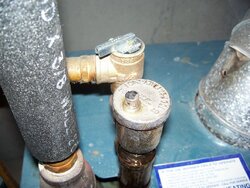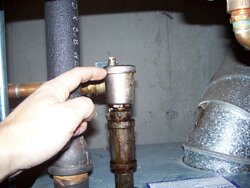Ok, here are a few pics.
I have been working more and more in my basement lately, and just not sure if I have never noticed this.
(Its an oil furnace with forced hot water)
I am guessing it is some sort of pressure valve, but I am not sure if there is supposed to be a small amount of water coming from it?
Basically, there was a little brownish stuff on the top of the valve, so I just wiped some of it off with a rag, and it seems like a little chunk of gook came out, and a steady flow of water. (The stuff around the top was sort of brownish/tan and flakey....guessing sediment as we have well water)
Should this little valve on top be open a little? A little water leaking out normal?
It seems like it should be open a small amount, but if I close (screw) it all the way down, I still get some water coming out. (I left it open a smidge)
Anything to worry about, or normal?
(The water isn't gushing out, just like a drip/drip, but when the top fills up with water it leaks down the side into the furnace)
I have been working more and more in my basement lately, and just not sure if I have never noticed this.
(Its an oil furnace with forced hot water)
I am guessing it is some sort of pressure valve, but I am not sure if there is supposed to be a small amount of water coming from it?
Basically, there was a little brownish stuff on the top of the valve, so I just wiped some of it off with a rag, and it seems like a little chunk of gook came out, and a steady flow of water. (The stuff around the top was sort of brownish/tan and flakey....guessing sediment as we have well water)
Should this little valve on top be open a little? A little water leaking out normal?
It seems like it should be open a small amount, but if I close (screw) it all the way down, I still get some water coming out. (I left it open a smidge)
Anything to worry about, or normal?
(The water isn't gushing out, just like a drip/drip, but when the top fills up with water it leaks down the side into the furnace)




 (flame suit on)
(flame suit on)